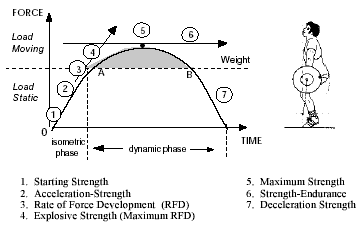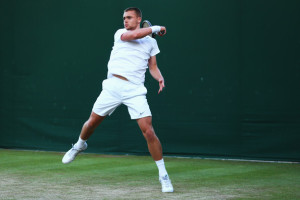What is Power and have You got some?
This blog has been on my ‘to do list’ for a long time but having just got back from the UKSCA Conference I have been inspired to finally write it!
So if you haven’t read up much on the APA training philosophy here’s a little background. We are all about developing complete athleticism which includes Suppleness, Skill, Speed, Strength and Stamina.
Today I want to go into a bit more detail about the Strength and Speed side of things because together these qualities lead to Powerful athletes. Powerful athletes are hot property in professional sport- these guys can make the difference between winning and losing. I often read articles which refer to ‘Explosiveness’ (related to Rate of Force Development (RFD) and Power) as being a desirable quality to develop in the gym with athletes. But at the same time I feel there is a lack of understanding as to what these qualities are and how to develop them. This blog will clear it up! But before we talk about Power we need to talk about Force because your vertical jump, sprint speed, agility and explosiveness are all directly related to your ability to produce force.
What is Force?
Force is a push or pull that can cause an object with mass to accelerate. We produce force from signals developed in the brain and delivered from nerves to control muscular contractions. These signals control the magnitude and the rate of muscular contraction to act on our skeleton to produce movement. To illustrate this point let’s use an example. We have a ping pong ball and a 200 lbs stone. To lift each will require a completely different strategy. Lifting the ping pong ball is easy and does not require much force. Our past experiences tell us the approximate weight of the ping pong ball and we send an appropriate signal to various muscles to pick-up the ping pong ball. Lifting the stone will require the integration of more muscular force from the legs, arms, core and back. The key point to appreciate is our nervous system controls our muscles. In turn our muscles contract to produce a force that can cause an object with mass to accelerate. Note, even if there is no movement, muscular contractions are still producing forces.
Why is it important?
Newton’s second law F=ma
In order to accelerate an object (assuming its mass stays constant) then we need to apply force.
Now obviously we know that weight training in the gym is the best way for our body to develop a greater ability to produce force but there is a point of diminishing returns as otherwise if this weren’t true the strongest athletes would be always be the fastest athletes. We would simply have a group of athletes get under a squat bar, and whoever squatted the most, would also be able to jump the highest. But there is more to jumping than just strength alone.
So this is where Power comes in.
What is Power?
In order to understand Power we need to understand Force-Time Curves.
Below we have a force and time curve. Memorize this graph, because it is one of the most important graphs for an athlete to understand. Notice force is plotted on the y axis and the time is plotted on the x axis. The Dashed Line is the force required to move a given object. Forces below this amount will not cause the object to move.
Let’s say the object is a barbell weighing 100kg and we want to deadlift this weight. Note a deadlift is taking a stationary weight from the ground and lifting it to a standing position. When we examine the force time curve we can identify unique strength qualities.
I’ve already covered a full explanation of the curve in a previous Blog but it’s worth going over it again.
”Starting Strength”– refers to the ability to produce force rapidly at the beginning of a muscular contraction prior to external movement. In our example, the weight will not move until sufficient force has been developed. This takes time and it reflects a very important quality. It is always produced under conditions of isometric muscle action. This fact alone has important consequences for strength training, because it dispels the opinion that the once-popular method of isometric training should be completely abandoned in modern training.
Athletes with a quick first step from a stationary position possess this ability. People often describe this quality as an explosive start. To train this quality the weight must be stationary and the athlete develops force to overcome its resting position. This quality is very different than acceleration strength. This quality is associated with getting yourself or an object moving which is at rest, so this is extremely important in sports like sprinting and American football/rugby who initiate the scrum from a stationary position.
It’s also extremely closely linked to deceleration strength, where you have to bring yourself to a complete stop and then immediately redirect the force for another sprint (often in a different direction).
For ease of discussion we can say there are two types of strength which are associated with high rates of force development during the actual movement of the bar:
”Acceleration Strength’‘- describes the ability to quickly achieve maximal external muscle force once dynamic movement has been initiated. Some athletes have tremendous abilities to develop force once moving, but have trouble developing power at the start.
“Explosive Strength” characterizes the ability to produce maximal force in a minimal time and is associated with peak Rates of Force Development. These are the forces we are observing when the bar is in motion. It is most commonly displayed in the fastest athletic movements when the contraction of the working muscles in the fundamental phases of the exercise is preceded by mechanical stretching (such as any plyometric, throwing, kicking, striking or rebounding action in many sports).
For me the exercises (such as Olympic weight lifting) that develop acceleration strength will also be the same ones we use to develop explosive strength, which we will describe shortly.
All of these qualities are associated with speed of movement and power but differ based on the load used. We might refer to exercises which work on the acceleration part of the Force-Time curve as strength-speed and exercises which work on the explosive part of the Force-Time curve as speed-strength- although I commonly see the strength speed exercises referred to as ‘explosive strength.‘ For speed-strength there is very little load applied to the body, 0 – 40% of an athletes’ maximal strength. In strength speed the load represents 40 – 60% of one’s maximal strength respectively. All of these qualities are important and elicit very different training effects. Current best practices emphasize a full spectrum approach, where an athlete is exposed to all ranges in a sequenced periodized approach. Research also reveals the method of loading to produce the best training effect and power output is exercises specific.
Olympic weightlifting is very popular as a tool to promote these qualities. Why is this so? Because Elite level Olympic weightlifters are capable of snatching over 150kg and can clean and jerk over 200kg. It is impossible to perform Olympic weightlifting movements at a slow speed. So you get a great combination of strength and speed. You get the same amount of power generated as with a plyometric bodyweight jump, but you also get strong at the same time!
The most powerful of all movements is the Olympic weightlifting action of the second pull of a Clean, peaking at 55.8 Watts/kilogram (Garhammer, J. J. Strength and Cond.Res. 7(2): 76-89. 1993)- more on this later!!
In all these instances, the switch from stretching to active contraction uses the elastic energy of the stretch to increase the power of the subsequent contraction.
Rate of Force Development
As indicated above, all the most powerful movements in sport are associated with rapid production of force.
Rate of Force Development is the term which refers to how rapidly force is produced. It includes the period prior to external movement and throughout the movement. Mathematically, it is given by the maximum value of the slope of the force-time curve (where this slope is called the Rate of Force Development, RFD). It is very important to distinguish maximal strength from rate of force development. Maximum strength is force produced irrespective of time, whereas rate of force development is a quality that refers to how rapidly force is produced. In sport we are much more concerned with rate of force development.
What constitutes a high RFD?
Based on the physiological properties of our skeletal muscles it takes roughly 500msec to reach maximal voluntary contraction. This is very important because in an explosive sport movement we do not have this amount of time to produce force. We have approximately .08 to .2 second to produce force. We call this window of time the explosive response period.
Simply described, explosiveness is the ability to create force quickly. This is the type of “explosiveness” a powerlifter would need to do a squat, or a bench press or a Deadlift. This type of explosiveness is associated more with starting strength and acceleration strength where the movement speed of the bar is low and muscle contractions are slow.
But in classical physics, power is defined as force times velocity, or rate of work performed. To have true power we must create movement quickly.
Therefore, we are most concerned with activities where the peak force is achieved in the explosive response period in under 200 ms. For me a simple description of Power might be:
A measure of the rate of doing work within the explosive response period associated with fast movement.
Examples of Power in Sport
Time is a key component. That’s why Power level is greater when a relatively light shot is put then when a heavy barbell is lifted explosively
- Power output in 7.25kg shot: 5,075 W
- Power output in 150kg Snatch: 3,163 W (33 W/kg)
- Power output in CMJ 2,997 W and 3,109 W in SJ
- Power output Bench press 300 W (4 W/kg), Squat and Deadlift 1100W (12 W/kg)
- Peak force in 7.25kg shot: 513 N
- Peak force in Squat and Deadlift 1,400 N
- Peak force in 150kg Snatch: 2,000 N
- Peak force in CMJ: 2,000 N
Though the exerted force is less in shot put the power is greater because of much higher speed of movement. However, remember that the second pull of the snatch and clean (which is part of the full lift) produces power of up to 55.8 W/kg!!!!!
What’s the difference between Power and RFD?
Explosive movements are associated with high levels of ‘power’ and/or ‘RFD.’ It is possible for a movement to be explosive without being externally fast- as in the case of a slowly moving barbell in a maximum attempt, for example.
In its simplest form the way I look at it is, tasks where you generate maximum power always result in a movement happening very fast. So powerful movements have to be performed FAST
Activities requiring you to generate maximum rate of force development may or may not result in a movement happening very fast. It is task dependant.
Movements performed slow (but with high RFD) can still be considered ‘explosive.’ Usually, however those athletes who are capable of producing the highest RFD are the same ones who are most powerful.
Have you got some?
Have a look at these athletic feats and see how you compare!!!!
[column width=”32%” padding=”2%”]
Powerlifting: Deadlift
[/column]
[column width=”32%” padding=”2%”]
Olympic Weight lifting- Clean & Jerk
[/column]
[column width=”32%” padding=”0″]
Plyometrics: Counter Movement Jump
[/column][end_columns]
Summary:
Fast movements are always explosive, but explosive movements are not always fast.
- If you’re not subscribed yet, click here to get free email updates, so we can stay in touch.
- Share this post using the buttons on the top and bottom of the post. As one of this blog’s first readers, I’m not just hoping you’ll tell your friends about it. I’m counting on it.
- Leave a comment, telling me where you’re struggling and how I can help













